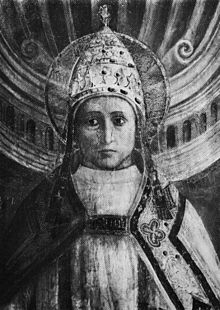Head of the Catholic Church from 199 to 217
| Pope Saint Zephyrinus | |
|---|---|
| Bishop of Rome | |
 15th century Lithography depicting St. Zephyrinus 15th century Lithography depicting St. Zephyrinus | |
| Church | Catholic Church |
| Papacy began | 199 |
| Papacy ended | 20 December 217 |
| Predecessor | Victor I |
| Successor | Callixtus I |
| Personal details | |
| Born | Rome, Italy, Roman Empire |
| Died | 20 December 217 Rome, Italy, Roman Empire |
| Sainthood | |
| Feast day | 20 December |
Pope Zephyrinus was the bishop of Rome from the year 199 until his death on 20 December 217. He was born in Rome, and succeeded Victor I. Upon his death on 20 December 217, he was succeeded by his principal advisor, Callixtus I. He is known for combating heresies and defending the divinity of Christ.
Papacy
During the 18-year pontificate of Zephyrinus, the young Church endured persecution under the Emperor Septimius Severus until his death in the year 211. To quote Alban Butler, "this holy pastor was the support and comfort of the distressed flock". According to St. Optatus, Zephyrinus also combated new heresies and apostasies, chief of which were Marcion, Praxeas, Valentine and the Montanists. Eusebius insists that Zephyrinus fought vigorously against the blasphemies of the two Theodotuses, who in response treated him with contempt, but later called him the greatest defender of the divinity of Christ. Although he was not physically martyred for the faith, his suffering – both mental and spiritual – during his pontificate have earned him the title of martyr, a title that was repealed 132 years after his death. He was accused of being seduced by Monarchian views.
Conflicts
During the reign of Emperor Septimius Severus (193–211), relations with the young Christian Church deteriorated, and in 202 or 203, the edict of persecution appeared, which forbade conversion to Christianity under the severest penalties.
Zephyrinus's predecessor, Pope Victor I, had excommunicated Theodotus the Tanner for reviving a heresy that Christ became God only after the Resurrection. Theodotus' followers formed a separate heretical community at Rome, ruled by another Theodotus, the Money Changer, and Asclepiodotus. Natalius, who was tortured for his faith during the persecution, was persuaded by Asclepiodotus to become a bishop in their sect in exchange for a monthly stipend of 150 denarii. Natalius then reportedly experienced several visions warning him to abandon these heretics. According to an anonymous work entitled The Little Labyrinth quoted by Eusebius, Natalius was whipped a whole night by an angel, and the next day, he donned sackcloth and ashes and weeping bitterly threw himself at the feet of Zephyrinus.
Feast day
A feast of St Zephyrinus, Pope and Martyr, held on 26 August, was inserted in the General Roman Calendar in the 13th century, but was removed in the 1969 revision, since he was not a martyr and 26 August is not the anniversary of his death which is 20 December, the day under which he is now mentioned in the Roman Martyrology. His feast is currently celebrated on 20 December in both the Extraordinary Form of the Roman Rite and within the Maronite Catholic Church, as well as in the Orthodox Church.
See also
Notes
- ^
 One or more of the preceding sentences incorporates text from a publication now in the public domain: Kirsch, Johann Peter (1912). "Pope St. Zephyrinus". In Herbermann, Charles (ed.). Catholic Encyclopedia. Vol. 15. New York: Robert Appleton Company.
One or more of the preceding sentences incorporates text from a publication now in the public domain: Kirsch, Johann Peter (1912). "Pope St. Zephyrinus". In Herbermann, Charles (ed.). Catholic Encyclopedia. Vol. 15. New York: Robert Appleton Company.
- A. Butler, Lives of the Saints Vol VIII, 1866
- Optatus, De Schismate 1,1
- Berti, Sæc 3. Diss. 1.t. 2 p 158
- Young, Frances M. (2006). "Monotheism and Christology". In Mitchell, Margaret M.; Young, Frances M. (eds.). Origins to Constantine. The Cambridge History of Christianity. Cambridge, UK: Cambridge University Press. pp. 458–61. ISBN 978-1-107-42361-9.
- Eusebius, Historia Ecclesiastica 5.28.9–12; translated by G.A. Williamson, Eusebius: The History of the Church (Harmonsworth: Penguin, 1965), pp. 236f
- "Calendarium Romanum" (Libreria Editrice Vaticana, 1969), p. 136
- "Martyrologium Romanum" (Libreria Editrice Vaticana, 2001 ISBN 88-209-7210-7)
References
- Rendina, Claudio, The Popes' Histories and Secrets (2002)
External links
 Media related to Pope Zephyrinus at Wikimedia Commons
Media related to Pope Zephyrinus at Wikimedia Commons
| Titles of the Great Christian Church | ||
|---|---|---|
| Preceded byVictor I | Bishop of Rome 199–217 |
Succeeded byCallixtus I |
| Saints of the Catholic Church | |
|---|---|
| Dicastery for the Causes of Saints Stages of canonization: Servant of God → Venerable → Blessed → Saint | |
| Virgin Mary | |
| Apostles | |
| Archangels | |
| Confessors |
|
| Disciples | |
| Doctors of the Church |
|
| Evangelists | |
| Church Fathers |
|
| Martyrs |
|
| Missionaries | |
| Patriarchs | |
| Popes |
|
| Prophets | |
| Virgins |
|
| See also | |